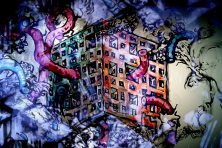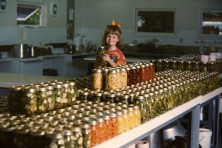Unconventional Books for Your Coffee Table
- Share
- Tweet
- Pin
- Share
The idea for a coffee table book (as in an oversized book filled with pictures or illustrations) has probably been around longer than the things we call coffee tables.
Typically, these are books filled with photographs centered on a theme, art books that reprint paintings, or home decorating books (which become interesting in that the book itself becomes part of the decorating process). The idea, of course, is that these books, laid out on a table, are readily at hand, and are easy to flip through, glance at, or quickly peruse while simultaneously demonstrating something about your personality to the guests who are sitting on your couch looking at your coffee table.
Fans of the Seinfeld TV show will certainly remember when the character of Kramer got it into his head to do a coffee table book consisting exclusively of photographs of coffee tables. Of course, Kramer and his publisher took the venture one step farther by putting small fold-out legs on the back cover of the finished book, thereby making the coffee table book, filled with photographs of coffee tables, a miniature coffee table. I still think this idea has merit and remain surprised that no one has actually printed one.
At this point you may be wondering whether coffee table books actually serve any purpose other than potentially impressing (or distressing) houseguests or serving as a home decorating accessory and it may surprise you that the answer is…yes! Coffee table books do serve one other important purpose: they provide a diversion for your guests if you need to leave the room to get more coffee, to use the bathroom, etc.
This last purpose – serving as diversion for guests in the event you need to leave them on their own – raises another rather interesting question: if the idea is to provide a diversion, does a coffee table book have to contain an abundance of visual material? Couldn’t a coffee table book consist of easily digestible information that can be readily browsed?
I, for one, believe that the answer to this last question is a resounding “Yes!” Not only will this type of coffee table book provide your guests with the opportunity to learn something new, it will also allow you – the owner of the book (and coffee table, for that matter) – the chance to idly peruse the book while you are waiting on a phone call, for example, and not feel that you are completely wasting time.
So with all of this as a rather long introduction, here are a few of my favorite, unconventional coffee table books, pulled from my own shelves (or lifted from a nearby table). You will note that all are reference books of one sort or another.
Dictionary of Global Culture, edited by Kwame Anthony Appiah and Henry Louis Gates, Jr., Alfred A. Knopf, 1996
The New York Times Book Review actually suggested that this volume would make a great coffee table book when it was reviewed. Organized alphabetically, with each page laid out in a two-column format, the book is filled with brief synopses of interesting people, ideas, movements, etc. As an example, pages 368 & 369 in my edition contain these entries: Kenyatta, Jomo; Keynes, John Maynard; Khasas; Khmelnytsky, Bohdan; and Khmer Rouge.
So you probably recognize Keynes and the Khmer Rouge, but did you know that the Khasas are a Nepalese ethnic tribe? That Jomo Kenyatta was an African leader for decolonization and the first president of an independent Kenya? Or that Khmelnytsky was the leader of the Zaporozhian Cossacks in the first half of the 17th century?
Dictionary of Imaginary Places, by Alberto Manguel and Gianni Guadalupi, Harcourt Brace & Company, 2000
Another reference organized alphabetically, but in this case the subjects are the imaginary lands that populate fiction through the ages. From Narnia to Middle Earth, from Pellucidar to Xanadu – if someone imagined it, you will find it within the pages of this book. And unlike the previous book, this one does contain maps of the imaginary lands when the imaginers have seen fit to create them.
Great Psychedelic Discography, by Martin Strong, illustrations by Harry Horse, Canongate, 1997 (out of print, unfortunately, and really expensive on the secondary market)
I recently loaned this book to our editor, Jim Lundstrom, who – like me – is old enough to remember a lot of this music. The sub-title is “A Trip through the 60s to the 90s: Psychedelia, Progressive, Experimental, Ambient, New Age, Retro-Psych and more,” which doesn’t begin to describe the immense amount of information contained in the pages of this book. Where else can you find the details on the entire library of music from the Electric Prunes – the band that gave us the classic 1967 anthem “I Had Too Much To Dream Last Night” and never recorded anything else that was worth owning.
So do you have a few unconventional coffee table books currently resting on a table in your home? Send me your favorites, folks. I’d love to hear what graces your tables.


